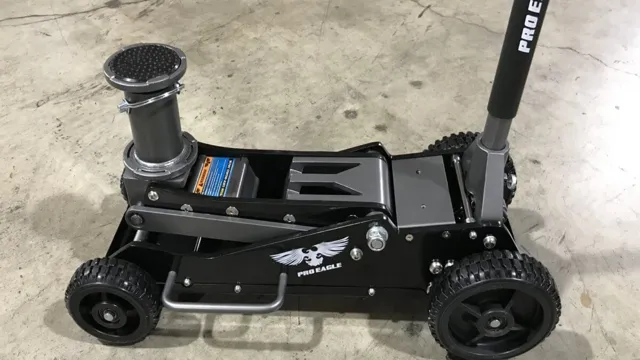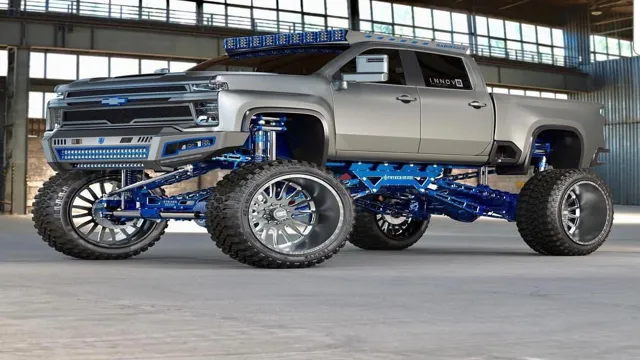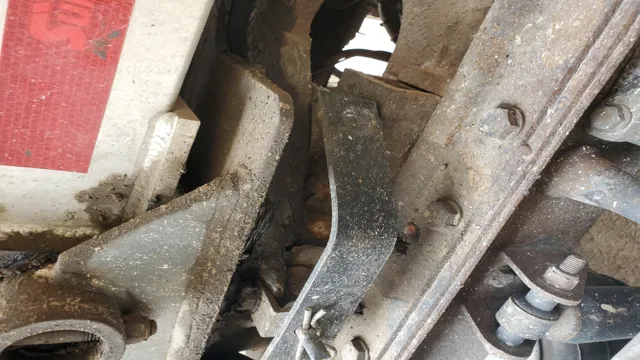Expert Tips and Tricks: How to Safely Jack Up Your Lifted Truck
Do you own a lifted truck and need to perform some maintenance underneath? Or perhaps you want to switch your wheels and tires for a new look? Either way, lifting a truck can make certain tasks more challenging, especially when it comes to jacking it up. But don’t worry, we’ve got you covered! In this blog post, we’ll walk you through the steps of how to safely jack up a lifted truck. So grab your gloves and let’s get started!
Overview of Lifted Truck Jacking
If you have a lifted truck, it’s important to know how to jack it up properly. First, make sure you have a sturdy jack that can handle the weight of your truck. Then, find a solid, flat surface to place the jack beneath the vehicle.
Position the jack directly under the designated lifting points, which can typically be found in your owner’s manual. If you’re unsure where to place the jack, consult a professional mechanic or do some research online to avoid damaging your truck. Once you’ve positioned the jack correctly, slowly lift the truck up and place jack stands beneath the vehicle to sustain it.
When lowering the truck, make sure to do so slowly and cautiously to avoid any accidents. With these steps in mind, you’ll be able to safely and effectively jack up your lifted truck when necessary.
Safety Precautions
Jacking up a lifted truck can be a complicated process, but the right precautions can make it safe and successful. First and foremost, it’s essential to use a high-quality jack that’s designed to handle the weight of your vehicle. Don’t rely on a cheap or makeshift jack that could give out under the weight of your truck.
It’s also crucial to choose a level and stable surface to place the jack on, as an uneven surface can cause a dangerous shift in weight. Additionally, you should always chock the wheels on the opposite end of the vehicle to prevent it from rolling while you work. And, of course, never crawl under a lifted truck that’s only supported by a jack.
By taking these safety measures, you can be confident in your ability to jack up your lifted truck safely.

Choose the Right Jack and Stands
When it comes to jacking up a lifted truck, it’s important to choose the right jack and stands to ensure safety and proper support. A hydraulic floor jack with a weight capacity that exceeds your vehicle’s weight is recommended. Also, consider purchasing jack stands that can handle the weight of your truck and have a locking pin feature for added security.
It’s important to properly position the jack and stands under the designated lifting points to avoid damage to the truck’s frame or undercarriage. Remember to never crawl underneath a lifted vehicle that is supported only by a jack and always take precautions to ensure safety while working on your truck. By choosing the right equipment and being cautious, you can safely and successfully jack up your lifted truck for maintenance or repairs.
Step-by-Step Process
Are you wondering how to jack up a lifted truck? Well, it’s not as difficult as it may seem. The first step is to make sure you have the proper equipment, including a high-lift jack compatible with your truck’s weight and a stable surface to place the jack. Next, position the jack under the truck’s frame, placing it in a spot that won’t harm any components.
Then, begin pumping the jack until the truck starts to lift off the ground. Make sure to double-check that the truck is level and secure before getting underneath it. When you’re finished with your task, lower the truck carefully and remove the jack.
Always remember to follow the steps carefully and be cautious when lifting a heavy vehicle. With these simple steps, you can confidently and safely jack up your lifted truck.
Step 1: Park on Flat and Solid Ground
When it comes to parking your car, one of the most important steps is finding flat and solid ground to park on. This is crucial for a few reasons. Firstly, parking on an uneven surface can cause damage to your car, especially if you leave it parked there for an extended period.
Uneven ground can also make it difficult to properly secure your car, which can result in it rolling away or being damaged by wind or other environmental factors. So, before you park, take the time to assess the ground and make sure it’s safe and stable. Look for a level surface that is free of debris, and avoid parking on soft ground like sand or mud, as this can cause your vehicle to sink or get stuck.
Overall, finding flat and solid ground to park on is a simple but important step in keeping your car safe and secure. So be sure to take the time to assess the ground before you park, so you can enjoy peace of mind knowing your car is protected.
Step 2: Loosen Lug Nuts and Position Jack and Stands
To begin changing a tire, the first step is to find a safe and flat location and turn on your hazard lights. Once you’ve parked the car, use a lug wrench to loosen the lug nuts on the flat tire. Don’t remove them completely yet, just make sure they are loose enough to unscrew with your fingers.
Next, take the jack and place it under the car in the designated jacking points – your vehicle’s manual will tell you where these are located. Start jacking up the car, but be sure to stop before the tires leave the ground. Once the car is raised, finish unscrewing the lug nuts by hand and remove the flat tire.
Before putting on the spare, take some time to inspect it for any damage or wear and tear. Remember to use jack stands to keep the car securely in place while you’re changing the tire. These necessary steps ensure safe and successful tire changing, making sure you get back on the road in no time.
Step 3: Jack up Truck carefully
When it comes to jacking up a truck, safety should always be your top priority. Before proceeding with this step, make sure you have the appropriate equipment, such as a good-quality hydraulic jack and sturdy jack stands. Once you’re ready, park your truck on a level surface and engage the parking brake.
Then, locate the jacking points under your vehicle. These are usually marked by notches or arrows on the chassis. Position your jack under the jacking point and begin to pump it carefully until the truck lifts off the ground.
It’s important to lift the truck evenly, and avoid lifting it too high, as this can cause instability. Once your truck is up, place the jack stands under the chassis, again using the jacking points as a reference. Slowly lower the truck onto the jack stands, and make sure it’s level and secure before continuing with your repairs or maintenance.
Following these steps will ensure that you raise and secure your vehicle safely and efficiently.
Step 4: Place Jack Stands
Now that your vehicle is lifted safely and securely with a floor jack, it’s time to place the jack stands to support it. This is a critical step in the process, as it adds an additional layer of safety and stability to prevent any accidents or injuries. First, locate the designated jack points on your vehicle’s chassis or frame to ensure proper positioning of the stands.
Then, carefully position the stands under the jack points and adjust them to the appropriate height. Make sure the stands are level and firmly planted on the ground before finally lowering the vehicle onto them. Remember to repeat this process for each jack point to ensure full support of your vehicle.
And when you’re finished, give the vehicle a gentle shake to test the stability of the jack stands. If everything is secure, you’re ready to start working safely underneath your vehicle. Always prioritize safety and take your time to ensure everything is correctly and securely in place before starting any work.
Stay safe and enjoy your project!
Step 5: Remove Wheels
Now that we have successfully loosened the lug nuts, it’s time to remove the wheels. This step is crucial in getting access to the brakes and other suspension components. To remove the wheels, avoid using excessive force and instead, gently wiggle them until they come free.
If they don’t budge, try lifting the vehicle with a hydraulic jack or turning the wheel slightly to release any pressure. When the wheels finally come off, take care not to damage the studs or hub. Inspect the wheels and clean them thoroughly before mounting them back on the vehicle.
With the wheels out of the way, we can now move onto the next stage of the maintenance process. Don’t forget to tighten the lug nuts once you’ve finished with the repairs. It’s always better to be safe than sorry!
Tips for Safe Lifting
If you’re looking to jack up a lifted truck, there are a few safety tips to keep in mind. First off, make sure you have the right equipment for the job. A high-quality hydraulic jack and jack stands are a must.
You’ll also want to ensure that the ground is level and firm before you begin lifting. Once you’ve secured your equipment and selected a safe lifting location, it’s important to pay attention to your body mechanics. Keep your feet shoulder-width apart, bend at the knees (not the waist), and lift with your legs.
Avoid twisting as you lift and never exceed your own lifting capacity. With these tips in mind, you can safely and confidently jack up your lifted truck.
Tip 1: Use a Hydraulic Jack
When it comes to lifting heavy objects, safety should always be a top priority. One of the best ways to ensure safe lifting is by using a hydraulic jack. This type of jack uses pressure to lift objects off the ground, which makes it much safer than traditional lifting methods.
In addition, hydraulic jacks come in a variety of sizes and weight capacities, so you can choose the right one for the job at hand. When using a hydraulic jack, it’s important to follow the manufacturer’s instructions carefully and to never exceed the weight capacity of the jack. With the right equipment and careful attention to detail, you can lift heavy objects safely and effectively.
Tip 2: Avoid Using the Rear Differential
When it comes to safe lifting, there are a few things to keep in mind to avoid injuries. One tip to keep in mind is to avoid using the rear differential. This component, found in many types of vehicles, can be easily damaged when used as a lifting point.
Instead, consider using the frame or other designated lifting points. It may take a bit more effort to identify the right lifting points, but it’s well worth it to avoid damaging your vehicle or causing harm to yourself. Remember, proper lifting techniques are critical to avoid injuries, so take the time to plan and execute your lifts safely.
Keep your focus on the task at hand and always seek help or guidance if needed. By following these tips, you can prevent injuries and ensure that your lifting operations are both safe and successful.
Tip 3: Always Use Jack Stands
Safe Lifting When it comes to lifting heavy objects, safety should always be your number one priority. One way to ensure that you’re lifting safely is to always use jack stands. These stands provide a stable base for your vehicle or equipment while you work on them.
Never rely on a jack alone to support your vehicle or equipment – jacks can fail, leaving you and your vehicle in a dangerous situation. Jack stands are easy to use and are available in a variety of sizes and weight capacities to suit your needs. When using jack stands, make sure that they are placed on a level surface and that your vehicle or equipment is properly positioned on the stands.
Always double-check that the jack stands are securely in place before beginning any work. With these simple precautions, you can lift and work on your vehicle or equipment safely and with confidence. Remember, it only takes one mistake to cause a serious injury – so always take your time and use the proper safety equipment.
Conclusion and Final Thoughts
In conclusion, jacking up a lifted truck requires a delicate balance of strength, precision, and a whole lot of patience. It’s like trying to sculpt a masterpiece out of a block of marble – the right tools and a steady hand can make all the difference. So if you’re feeling adventurous and ready to take on the task, just remember to always follow safety guidelines and don’t be afraid to ask for help if you need it.
After all, teamwork makes the dream work…
or in this case, the lift work.”
FAQs
What tools do I need to jack up a lifted truck?
To jack up a lifted truck, you will need a hydraulic jack, jack stands, a lug wrench, and wheel chocks.
How do I safely jack up a lifted truck?
To safely jack up a lifted truck, start by parking on a level surface and chocking the wheels. Then, use the hydraulic jack to lift the truck by its frame, and place jack stands under the frame for support before removing the wheels.
Can I use a regular car jack to lift a lifted truck?
It is not recommended to use a regular car jack to lift a lifted truck. A hydraulic jack designed for trucks and SUVs is needed to handle the weight and height of a lifted truck.
How high should I lift my lifted truck to perform maintenance?
The height you need to lift your lifted truck depends on the type of maintenance you need to perform. As a general rule, raise the truck high enough to access the area you need to work on, but don’t exceed the manufacturer’s recommended height for the jack stands.




